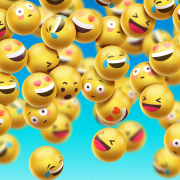Emojis Cross Cultures Too
With the proliferation of digital communication and the rise of personal devices capable of Internet connectivity, the ways we communicate in our everyday lives have been changing. It’s not just about conversations face to face, or telephone calls where we listen to only voices, there’s now video conferencing, e-mail, text messages, and, of course, instant messaging. The rudimentary “smilies” and other indications of emotion from early online communication have evolved over the years.
They were first known as “emoticons,” that were typed out using creative placement of punctuation marks on a text window. Today, they’re also known as “emojis” and they’ve come a long way from a colon and a close bracket typed one after the other to indicate a smile, or the use of the letters LOL to show “laughing out loud.”
Today’s emojis are an integral part of online communication, built into most communication software to be colorful, animated and far more expressive than the early emoticons they came from. And it should come as no surprise that, like different languages themselves, they have a different significance and different sensibility for different people.
Cultural Preferences
While displays of emotion such as smiling, laughing and crying are universally recognized by everyone, regardless of their culture, there are still well-defined cultural boundaries and preferences for these expressions of feeling.
While displays of emotion such as smiling, laughing and crying are universally recognized by everyone, regardless of their culture, there are still well-defined cultural boundaries and preferences for these expressions of feeling, and how appropriate they are. For example, laughing is always an appropriate response to something humorous, but the Japanese prefer the use of a more polite, restrained laughter, rather than the more boisterous, open mouthed, loud laughing that Americans use to show great appreciation for a good joke.
In the same way, while some in the West may consider it odd, or even rude for a nurse to smile or giggle while treating someone’s injury and causing them discomfort when it happens, the smile or laugh is a catch-all reaction in Thailand—and other Asian cultures—that can be the equivalent of embarrassment or blushing, and is not intended to convey amusement at the suffering of another person.
And that’s why even though the same emojis are present in any smartphone, tablet or other computing device being sold around the world, the frequency and acceptability of emojis can vary from culture to culture as well.
Emojis Around The World
One obvious example of this phenomenon is the use of the heart emoji. Everyone associates it with feelings of love, want, or affection, but the French come in at #1 as being the culture that uses the heart emoji more than any other, and are the only culture where the heart, not the smiley, is the most frequently used emoji. Flower and plant related imagery on the other hand, is used most frequently by Arabic speakers, likely a nod to the value of plant imagery in Arabic faith, and perhaps even a reaction against using human imagery, as the faith dictates.
Then there are the Australians, who use alcohol emoji imagery more than other cultures, meaning that it might actually be advantageous in your Aussie online dealings to break the ice and forge a bond faster by showing that you have the same appreciation for a good drink that they do.
Just remember, even though you may be using the same communication software and same emojis as someone on the other side of the planet, the way those emojis are received and interpreted can vary from culture to culture.


















Leave a Reply
Want to join the discussion?Feel free to contribute!